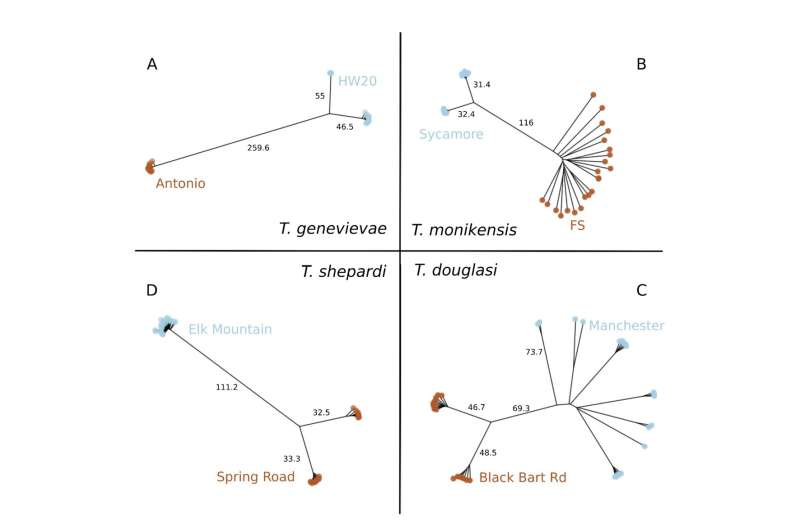
Neighbour-joining networks of pairwise distances between individuals within parthenogenetic Timema species: A. T. genevievae. B. T. monikensis. C. T. douglasi. D. T. shepardi. Individuals of the two studied populations in each species are distinguished by brown and blue labels. Credit: Proceedings of the Royal Society B: Biological Sciences (2023). DOI: 10.1098/rspb.2023.0404
A team of ecologists and evolutionary biologists at the University of Lausanne, Switzerland, has found that some normally asexual species of stick insects, which are known to reproduce via parthenogenesis, occasionally mate to enhance the gene pool.
In their paper published in Proceedings of the Royal Society B, the group describes how they sequenced the genomes of four species of stick insect that are known to reproduce via parthenogenesis and what they learned by doing so.
Prior research has shown that some species of stick insect, of the genus Timema, do not have to mate to produce offspring. They instead reproduce through a process known as parthenogenesis—where a creature reproduces by producing an egg that does not need to be fertilized to mature.
When reproducing this way, such creatures produce near clones of themselves, which means that most of their offspring tend to be female—although there is the rare possibility of a male resulting from this mode of reproduction. Parthenogenesis has been found in some invertebrates (including these species of stick insect) and some plants.
Prior research has also shown that creatures that reproduce via parthenogenesis tend to have less genetic diversity and because of that tend to have more difficulty adjusting to changes in their environment. In this new effort, the research team was wondering how stick insects might fare in light of global warming. Prior research has suggested that the insects have been reproducing via parthenogenesis for as long as a million years, seemingly making them particularly vulnerable to climate change.
To learn more, they went out into the field and captured multiple samples of four species of stick insects that are already known to reproduce via parthenogenesis. The research team sequenced the genes of eight populations from four stick inspect species that rely on parthenogenesis. In six of those populations, they found low genetic diversity, which points towards long periods of uninterrupted parthenogenesis.
However, in two of the populations belonging to the species Timema douglasi and T. monikensis, Susana Freitas and her team found evidence of more genetic diversity than should be the case for a creature that reproduces without mating. This suggests that these two species occasionally practice cryptic sex, where fertilization occurs post-mating and tends to have a male bias.
The research team concludes by suggesting their findings indicate that some creatures, such as stick insects, appear to be capable of adapting to environmental changes by adapting the means by which they reproduce.
More information:
Susana Freitas et al, Evidence for cryptic sex in parthenogenetic stick insects of the genus Timema, Proceedings of the Royal Society B: Biological Sciences (2023). DOI: 10.1098/rspb.2023.0404
© 2023 Science X Network
Citation:
Some stick insects that normally reproduce through parthenogenesis found to mate on occasion (2023, September 20)
retrieved 20 September 2023
from https://phys.org/news/2023-09-insects-parthenogenesis-occasion.html
This document is subject to copyright. Apart from any fair dealing for the purpose of private study or research, no
part may be reproduced without the written permission. The content is provided for information purposes only.
>>> Read full article>>>
Copyright for syndicated content belongs to the linked Source : Phys.org – https://phys.org/news/2023-09-insects-parthenogenesis-occasion.html














![[News] China Makes Breakthrough in Chip Technology, Paving the Way for Lithography Advancements – TrendForce](https://earth-news.info/wp-content/uploads/2025/11/324664-news-china-makes-breakthrough-in-chip-technology-paving-the-way-for-lithography-advancements-trendforce-360x180.jpg)
















